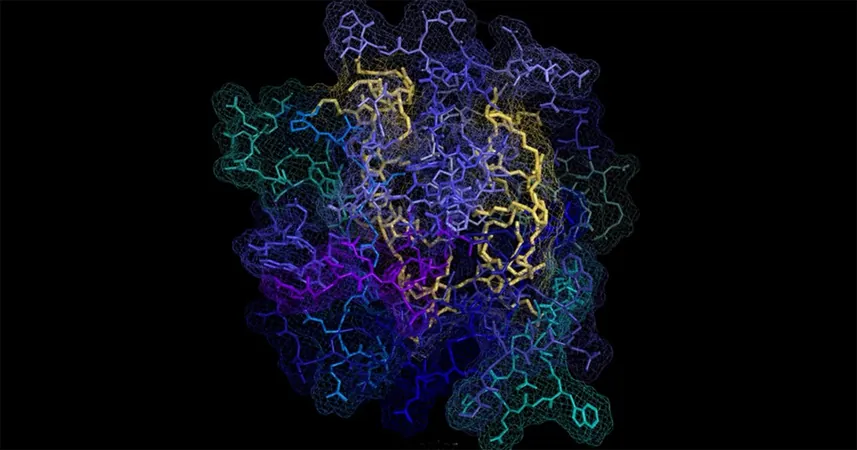
Breakthrough in Huntington's Disease Treatment: Revolutionary Polymer Blocks Protein Clumping!
2024-11-01
Author: Wei
Introduction
Scientists at Northwestern University and Case Western Reserve University have just made an exciting breakthrough in the fight against Huntington's disease, a devastating genetic disorder that leads to severe neurodegeneration. This pioneering research introduced the first polymer-based therapy designed specifically to halt the misfolding and aggregation of proteins that characterize the disease.
Understanding Huntington's Disease
Huntington's disease, caused by a genetic mutation, leads to the production of malfunctioning proteins that accumulate in nerve cells. This buildup disrupts normal cell function, ultimately resulting in cell death. The consequences for patients are dire—loss of mobility, speech, and cognitive function, with most individuals succumbing to the disease within 10 to 20 years after symptoms manifest.
Innovative Treatment Approach
The innovative treatment involves peptide-brush polymers, which act as a barrier to prevent protein interactions. In laboratory studies with mice, this therapy successfully preserved neuronal health and reversed some of the neurologic symptoms. Significantly, the treated mice reported no noteworthy side effects, underscoring the therapy's promise as a nontoxic alternative.
Future of the Treatment
As the polymer's research continues, scientists envision a future where this treatment could potentially be delivered as a weekly injection, aiming to either delay the disease's onset or alleviate its symptoms in affected individuals.
Research Publication and Statements
Published on November 1 in the journal Science Advances, lead researcher Nathan Gianneschi, a chemistry professor at Northwestern, shared his passionate commitment to this work. “Huntington’s is a horrific, insidious disease. If you have this genetic mutation, you will inevitably develop the condition. There’s no way out, and patients critically need help,” he remarked.
Foundational Research
Moreover, the basis of this remarkable therapy stems from earlier research conducted by Xin Qi’s laboratory. In 2016, Qi and her team discovered a protein – valosin-containing protein (VCP) – that interacts abnormally with the mutant Huntington protein. This interaction significantly contributes to protein clumping within mitochondria, leading to cellular dysfunction and death.
Advancements in Peptide Application
Additionally, Qi identified a naturally occurring peptide that interrupted the binding between VCP and the Huntington protein, offering initial hope as it prevented cell demise. However, the peptide had limitations, such as its rapid breakdown in the body and challenges crossing the crucial blood-brain barrier.
Creating a More Effective Polymer
To amplify the peptide's effectiveness, Gianneschi and his collaborators crafted a biocompatible polymer that houses multiple copies of the peptide. This structure not only shields the peptides from degradation, but it also aids in traversing the blood-brain barrier more effectively. Their experimental results are promising, demonstrating that the polymer treatment remained in the body 2,000 times longer than typical peptides, protecting mitochondrial integrity and allowing treated mice to exhibit behaviors similar to their healthy counterparts.
Researcher's Motivation and Broader Applications
As Gianneschi continues to refine this groundbreaking polymer, he also aims to explore its potential applications in treating other neurodegenerative diseases. His personal connection to Huntington's, with a childhood friend diagnosed at just 18, fuels his determination: “I remain highly motivated—both personally and scientifically—to continue down this path.”
Conclusion
With continued innovation and commitment, this groundbreaking polymer therapy may offer new hope to those affected by Huntington’s disease, heralding a future where effective management or even reversal of symptoms could become a reality.



 Brasil (PT)
Brasil (PT)
 Canada (EN)
Canada (EN)
 Chile (ES)
Chile (ES)
 Česko (CS)
Česko (CS)
 대한민국 (KO)
대한민국 (KO)
 España (ES)
España (ES)
 France (FR)
France (FR)
 Hong Kong (EN)
Hong Kong (EN)
 Italia (IT)
Italia (IT)
 日本 (JA)
日本 (JA)
 Magyarország (HU)
Magyarország (HU)
 Norge (NO)
Norge (NO)
 Polska (PL)
Polska (PL)
 Schweiz (DE)
Schweiz (DE)
 Singapore (EN)
Singapore (EN)
 Sverige (SV)
Sverige (SV)
 Suomi (FI)
Suomi (FI)
 Türkiye (TR)
Türkiye (TR)
 الإمارات العربية المتحدة (AR)
الإمارات العربية المتحدة (AR)